人教版初一英语上册语法总结大全
- 格式:doc
- 大小:212.00 KB
- 文档页数:24
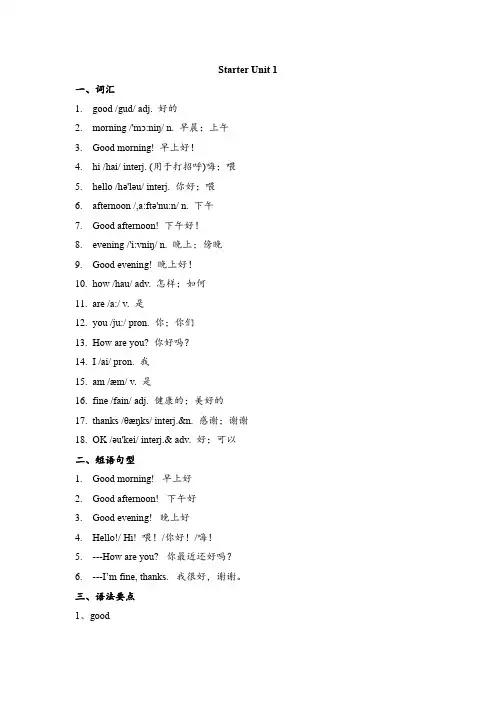
Starter Unit 1一、词汇1.good /gud/ adj. 好的2.morning /'mɔ:niŋ/ n. 早晨;上午3.Good morning! 早上好!4.hi /hai/ interj. (用于打招呼)嗨;喂5.hello /hə'ləu/ interj. 你好;喂6.afternoon /,a:ftə'nu:n/ n. 下午7.Good afternoon! 下午好!8.evening /'i:vniŋ/ n. 晚上;傍晚9.Good evening! 晚上好!10.how /hau/ adv. 怎样;如何11.are /a:/ v. 是12.you /ju:/ pron. 你;你们13.How are you? 你好吗?14.I /ai/ pron. 我15.am /æm/ v. 是16.fine /fain/ adj. 健康的;美好的17.thanks /θæŋks/ interj.&n. 感谢;谢谢18.OK /əu'kei/ interj.& adv. 好;可以二、短语句型1.Good morning!早上好2.Good afternoon!下午好3.Good evening!晚上好4.Hello!/ Hi! 喂!/你好!/嗨!5.---How are you?你最近还好吗?6.---I’m fine, thanks.我很好,谢谢。
三、语法要点1、goodgoods n.(pl.)货物;商品be good for...对...有益/有用be good at...擅长于.2、morning n.早晨;上午“在早上、下午、晚上”用介词in,即in the morning/aftermoon/evening而在具体某一天的早上、下午、晚上用on,如:on Mondaymorning“在周一早上”。
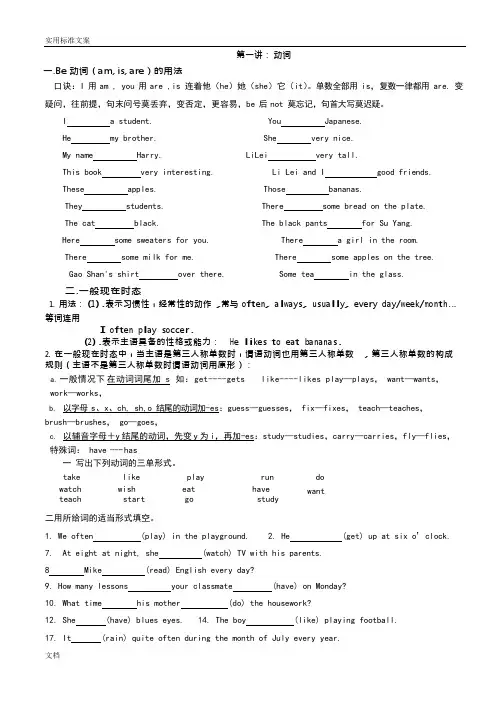
第一讲:动词一.Be 动词(am, is, are)的用法口诀:I 用 am , you 用 are ,is 连着他(he)她(she)它(it)。
单数全部用 is,复数一律都用 are. 变疑问,往前提,句末问号莫丢弃,变否定,更容易,be 后 not 莫忘记,句首大写莫迟疑。
I a student. You Japanese.He my brother. She very nice.My name Harry. LiLei very tall.This book very interesting. Li Lei and I good friends.These apples. Those bananas.They students. There some bread on the plate.The cat black. The black pants for Su Yang.Here some sweaters for you. There a girl in the room.There some milk for me. There some apples on the tree.Gao Shan's shirt over there. Some tea in the glass.二.一般现在时态1.用法:(1).表示习惯性,经常性的动作,常与o f t e n,a l w a y s,u s u a ll y,e v e r y d a y/w ee k/m o n t h…等词连用I o f t e n p l a y s o cc e r.(2).表示主语具备的性格或能力:H e li k e s t o e a t b a n a n a s.2.在一般现在时态中,当主语是第三人称单数时,谓语动词也用第三人称单数, 第三人称单数的构成规则(主语不是第三人称单数时谓语动词用原形):a.一般情况下在动词词尾加 s 如:get----gets like----likes play—plays, want—wants,work—works,b.以字母 s、x、ch, sh,o 结尾的动词加-es:guess—guesses, fix—fixes, teach—teaches,brush—brushes, go—goes,c.以辅音字母+y 结尾的动词,先变y 为i,再加-es:study—studies,carry—carries,fly—flies,特殊词: have --- has一写出下列动词的三单形式。
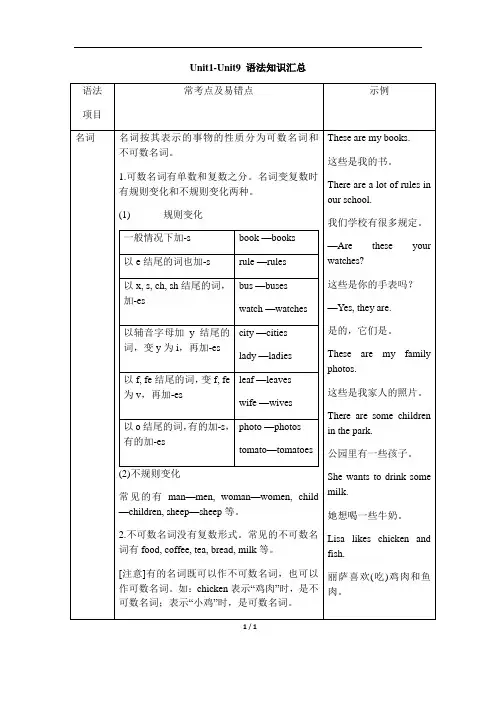
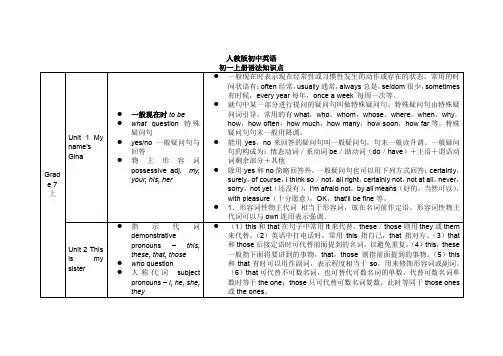
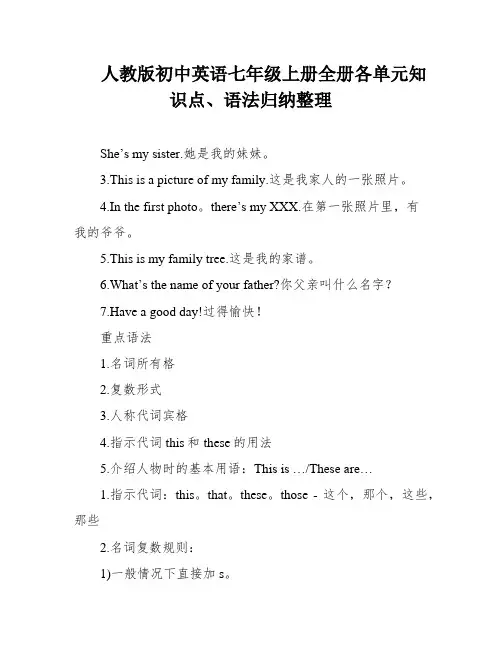
人教版初中英语七年级上册全册各单元知识点、语法归纳整理She’s my sister.她是我的妹妹。
3.This is a picture of my family.这是我家人的一张照片。
4.In the first photo。
there’s my XXX.在第一张照片里,有我的爷爷。
5.This is my family tree.这是我的家谱。
6.What’s the name of your father?你父亲叫什么名字?7.Have a good day!过得愉快!重点语法1.名词所有格2.复数形式3.人称代词宾格4.指示代词this和these的用法5.介绍人物时的基本用语:This is …/These are…1.指示代词:this。
that。
these。
those - 这个,那个,这些,那些2.名词复数规则:1)一般情况下直接加s。
2)以s,x,sh,ch结尾的加es。
3)以辅音字母加y结尾的将y变i再加es。
4)以o结尾的加s或es。
(有生命+es物生命加s)5)以f/fe结尾的名词,先将f/fv变成v再加es。
3.人称代词:I。
he。
she。
it和they - 我,他,她,它,他们/她们/它们4.重点短语:Is this/that your。
- 这/那是你的……吗?Yes。
it is。
/ No。
it isn't。
- 是的,是它。
/ 不,不是。
XXX。
- 这些/那些是我的……Here are。
- 这里有……This/That is my。
- 这/那是我的……Have a good day。
- 祝你玩得愉快!Excuse me for interrupting。
but could I ask you a n?Thank you very much.Could you please speak in English?Do you enjoy playing computer games?Have you checked in the lost and found case to see if your item is there?Please call 685-6034 to reach me.I lost my school ID card and need to find it.I need a set of pencils for my art class.Key XXX structures:Is that your school bag?No。
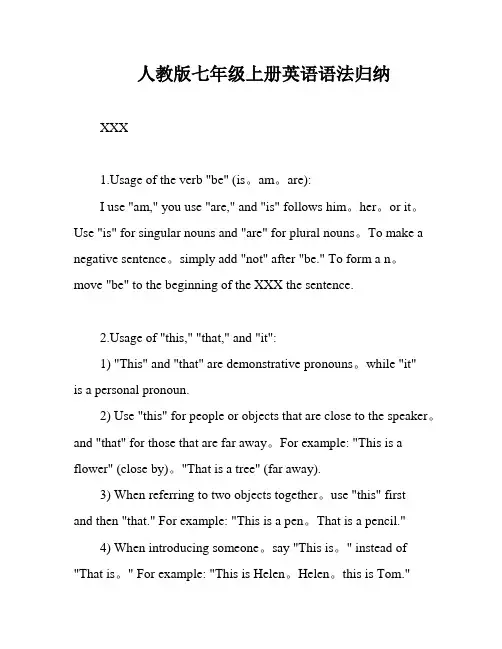
人教版七年级上册英语语法归纳XXXage of the verb "be" (is。
am。
are):I use "am," you use "are," and "is" follows him。
her。
or it。
Use "is" for singular nouns and "are" for plural nouns。
To make a negative sentence。
simply add "not" after "be." To form a n。
move "be" to the beginning of the XXX the sentence.age of "this," "that," and "it":1) "This" and "that" are demonstrative pronouns。
while "it"is a personal pronoun.2) Use "this" for people or objects that are close to the speaker。
and "that" for those that are far away。
For example: "This is a flower" (close by)。
"That is a tree" (far away).3) When referring to two objects together。
use "this" firstand then "that." For example: "This is a pen。
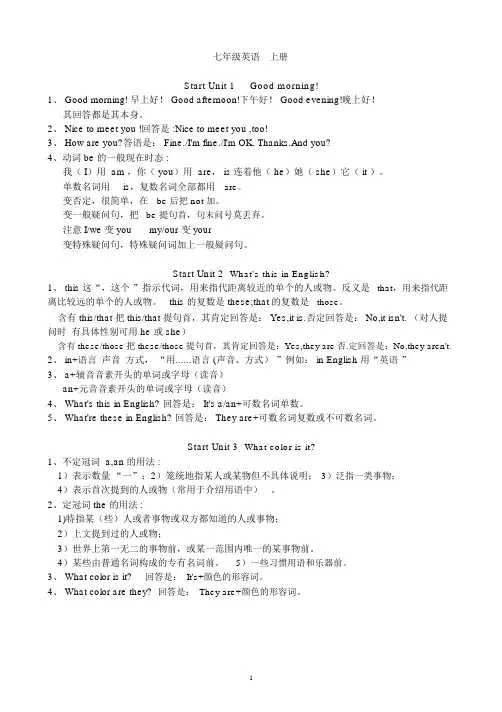
七年级英语上册Start Unit 1Good morning!1、 Good morning! 早上好! Good afternoon!下午好! Good evening!晚上好!其回答都是其本身。
2、 Nice to meet you !回答是 :Nice to meet you ,too!3、 How are you?答语是: Fine./I'm fine./I'm OK. Thanks.And you?4、动词 be 的一般现在时态 :我( I)用 am ,你( you)用 are, is 连着他( he)她( she)它( it )。
单数名词用is,复数名词全部都用are。
变否定,很简单,在be 后把 not 加。
变一般疑问句,把be 提句首,句末问号莫丢弃。
注意 I/we 变 you my/our 变 your变特殊疑问句,特殊疑问词加上一般疑问句。
Start Unit 2What's this in English?1、 this 这“,这个”指示代词,用来指代距离较近的单个的人或物。
反义是that,用来指代距离比较远的单个的人或物。
this 的复数是 these;that的复数是those。
含有 this/that 把 this/that 提句首,其肯定回答是: Yes,it is.否定回答是: No,it isn't. (对人提问时有具体性别可用 he 或 she)含有 these/those把 these/those提句首,其肯定回答是:Yes,they are否.定回答是:No,they aren't.2、 in+语言声音方式,“用......语言 (声音、方式)”例如: in English 用“英语”3、 a+辅音音素开头的单词或字母(读音)an+元音音素开头的单词或字母(读音)4、 What's this in English? 回答是: It's a/an+可数名词单数。
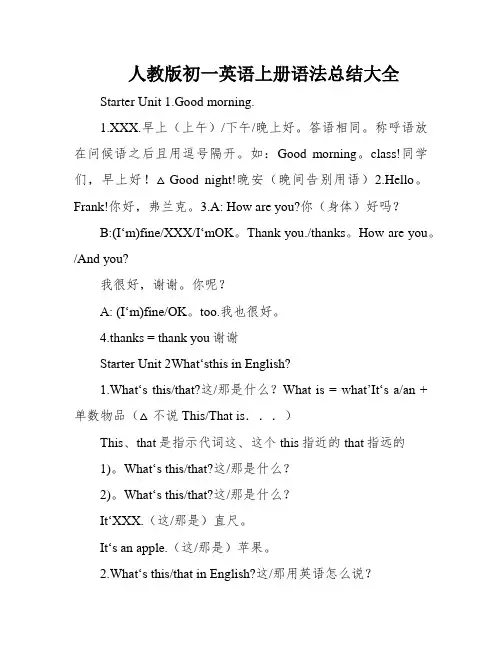
人教版初一英语上册语法总结大全Starter Unit 1.Good morning.1.XXX.早上(上午)/下午/晚上好。
答语相同。
称呼语放在问候语之后且用逗号隔开。
如:Good morning。
class!同学们,早上好!△Good night!晚安(晚间告别用语)2.Hello。
Frank!你好,弗兰克。
3.A: How are you?你(身体)好吗?B:(I‘m)fine/XXX/I‘mOK。
Thank you./thanks。
How are you。
/And you?我很好,谢谢。
你呢?A: (I‘m)fine/OK。
too.我也很好。
4.thanks = thank you谢谢Starter Unit 2What‘sthis in English?1.What‘s this/that?这/那是什么?What is = what’It‘s a/an +单数物品(△不说This/That is...)This、that是指示代词这、这个this指近的that指远的1)。
What‘s this/that?这/那是什么?2)。
What‘s this/that?这/那是什么?It‘XXX.(这/那是)直尺。
It‘s an apple.(这/那是)苹果。
2.What‘s this/that in English?这/那用英语怎么说?It‘s a/an +单数物品(△不说This/That is...)What‘s this in English?这用英语怎么说?It’s a jacket.夹克衫What‘s that in English?那用英语怎么说?It’s an orange.橘子。
in +语言:用某种语言in为介词XXX用汉/英/日语3.a和an是不定冠词,只用在可数名词单数前面,表示―一‖。
a用在以辅音音素开头的单词前;an用在以元音音素开头的单词前。
这里的元音音素和辅音音素是指读音,而不是指字母。
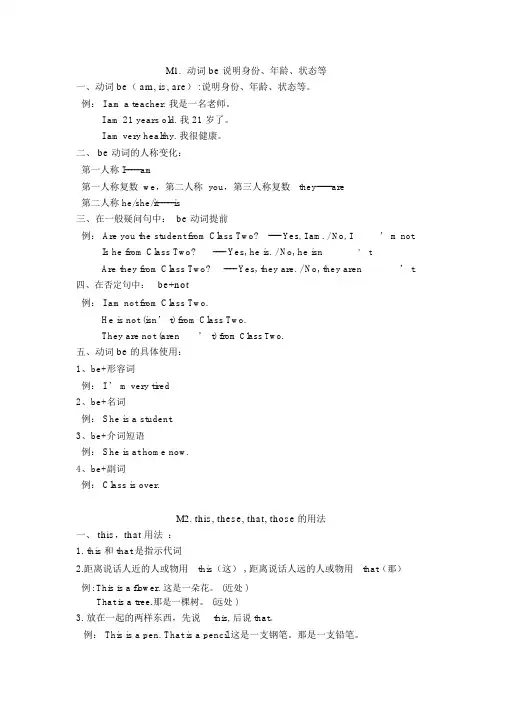
M1. 动词 be 说明身份、年龄、状态等一、动词 be( am, is, are) :说明身份、年龄、状态等。
例: I am a teacher. 我是一名老师。
I am 21 years old. 我 21 岁了。
I am very healthy. 我很健康。
二、 be 动词的人称变化:第一人称 I-----am第一人称复数 we,第二人称 you,第三人称复数they-----are 第二人称 he/she/it-----is三、在一般疑问句中: be 动词提前例: Are you the student from Class Two?---- Yes, I am. / No, I Is he from Class Two?---- Yes, he is. / No, he isn’ t.Are they from Class Two? ---- Yes, they are. / No, they aren ’ m not.’ t.四、在否定句中:be+not例: I am not from Class Two.He is not (isn’ t) from Class Two.They are not (aren’ t) from Class Two.五、动词 be 的具体使用:1、be+形容词例: I ’ m very tired2、be+名词例: She is a student.3、be+介词短语例: She is at home now.4、be+副词例: Class is over.M2. this, these, that, those的用法一、 this,that 用法:1. this 和 that 是指示代词2.距离说话人近的人或物用this(这) , 距离说话人远的人或物用that(那)例: This is a flower. 这是一朵花。
(近处 )That is a tree.那是一棵树。
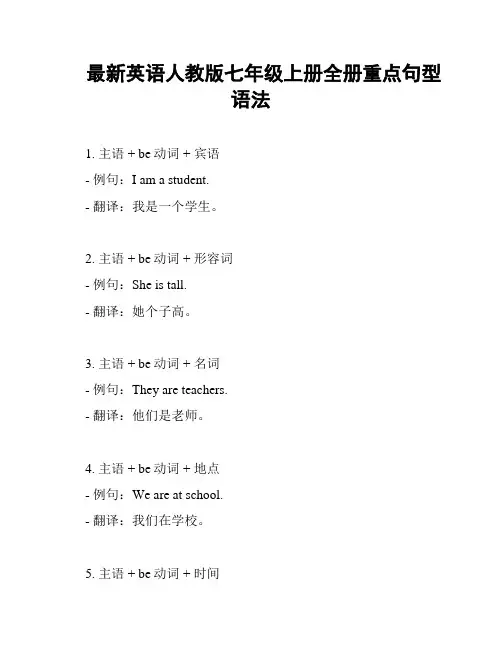
最新英语人教版七年级上册全册重点句型语法1. 主语 + be动词 + 宾语- 例句:I am a student.- 翻译:我是一个学生。
2. 主语 + be动词 + 形容词- 例句:She is tall.- 翻译:她个子高。
3. 主语 + be动词 + 名词- 例句:They are teachers.- 翻译:他们是老师。
4. 主语 + be动词 + 地点- 例句:We are at school.- 翻译:我们在学校。
5. 主语 + be动词 + 时间- 例句:He is in the classroom at 8 o'clock. - 翻译:他在八点钟在教室里。
6. 主语 + be动词 + 副词- 例句:I am here.- 翻译:我在这里。
7. 主语 + have + 名词- 例句:We have a book.- 翻译:我们有一本书。
8. 主语 + have + 动词过去分词- 例句:He has finished his homework.- 翻译:他已经完成了他的作业。
9. 主语 + have + to + 动词原形- 例句:They have to study for the test.- 翻译:他们必须为考试研究。
10. 主语 + can + 动词原形- 例句:She can swim.- 翻译:她会游泳。
11. 主语 + can + 动词原形 + 物品- 例句:We can ride bicycles.- 翻译:我们会骑自行车。
12. 主语 + can't + 动词原形- 例句:He can't speak Chinese.- 翻译:他不会说中文。
13. 主语 + like + 名词/动词/动词-ing- 例句:They like basketball.- 翻译:他们喜欢篮球。
14. 主语 + don't/doesn't + like + 名词/动词/动词-ing - 例句:She doesn't like swimming.- 翻译:她不喜欢游泳。
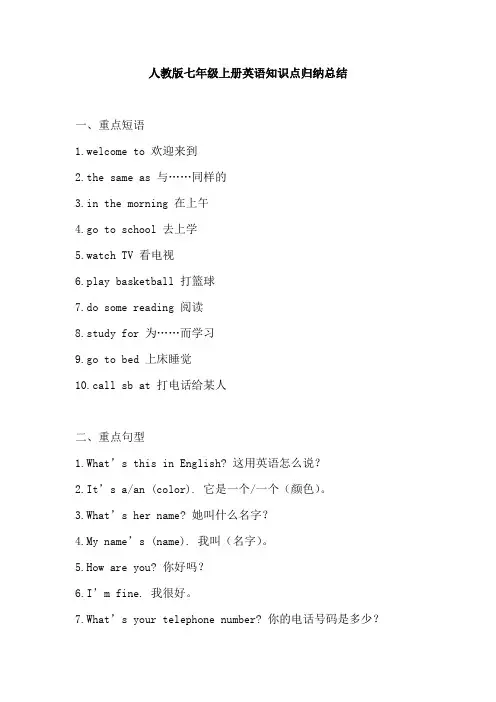
人教版七年级上册英语知识点归纳总结
一、重点短语
1.welcome to 欢迎来到
2.the same as 与……同样的
3.in the morning 在上午
4.go to school 去上学
5.watch TV 看电视
6.play basketball 打篮球
7.do some reading 阅读
8.study for 为……而学习
9.go to bed 上床睡觉
10.call sb at 打电话给某人
二、重点句型
1.What’s this in English? 这用英语怎么说?
2.It’s a/an (color). 它是一个/一个(颜色)。
3.What’s her name? 她叫什么名字?
4.My name’s (name). 我叫(名字)。
5.How are you? 你好吗?
6.I’m fine. 我很好。
7.What’s your telephone number? 你的电话号码是多少?
8.Can you help me? 你能帮助我吗?
9.What time is it? 现在几点了?
10.It’s time to do sth. 是做某事的时间了。
三、重点语法
1.名词的复数形式。
2.动词的第三人称单数形式。
3.名词的格。
4.疑问句和否定句的构成和回答。
5.时间表达法。
人教版七年级英语上册语法大全一、名词(Nouns)名词是指人、物、地点、动物和概念等的名称。
名词可以分为可数名词和不可数名词。
1. 可数名词(Classifiable Nouns):可数名词可以用数字进行计数,并且可以有单数和复数形式。
如:book(书),apple(苹果),dog(狗),student(学生)等。
2. 不可数名词(Uncountable Nouns):不可数名词不可以用数字进行计数,只有单数形式。
如:water (水),music(音乐),money(钱)等。
二、冠词(ARTICLES)冠词是用于修饰名词的词语,在英语中主要有三种冠词:定冠词、不定冠词和零冠词。
1. 定冠词(The Definite Article):定冠词是指特指某个人或物的冠词,只有一个形式,即 "the"。
如:the book(这本书),the cat(这只猫)等。
2. 不定冠词(The Indefinite Article):不定冠词是指泛指人或物的冠词,有两个形式,即"a" 和"an"。
如:a book(一本书),an apple(一个苹果)等。
3. 零冠词(Zero Article):零冠词是指名词前没有任何冠词修饰的情况,也可以表示泛指。
如:I like flowers(我喜欢花)。
三、形容词(Adjectives)形容词是用来描述或修饰名词的词语,通常位于名词前面。
形容词可以分为具体形容词和抽象形容词。
1. 具体形容词(Concrete Adjectives):具体形容词用来描述或修饰可以通过感官观察得到的名词。
如:red (红色的),big(大的),beautiful(美丽的)等。
2. 抽象形容词(Abstract Adjectives):抽象形容词用来描述或修饰无法通过感官观察得到的名词,表示情感、状态或性质等。
如:happy(快乐的),difficult(困难的),interesting(有趣的)等。
七年级英语上册语法1.动词be(is, am, are)的用法我(I)用am, 你(you)用are,is跟着他(he),她(she),它(it)。
单数名词用is,复数名词全用are。
变否定,更容易,be后not加上去。
变疑问,往前提,句末问号莫丢弃。
还有一条须注意,句首大写莫忘记。
2.this,that和it用法1) this和that是指示代词,it是人称代词。
2) 距离说话人近的人或物用this, 距离说话人远的人或物用that。
如:This is a flower. 这是一朵花。
(近处)That is a tree. 那是一棵树。
(远处)3) 放在一起的两样东西,先说this, 后说that。
如:This is a pen. That is a pencil.4) 向别人介绍某人时说This is…, 不说That is…。
如:This is Helen. Helen, this is Tom. 这是海伦,海伦,这是汤姆。
5) This is 不能缩写, 而That is可以缩写。
如:This is a bike. That’s a car. 这是一辆自行车。
那是一辆轿车。
6) 打电话时,介绍自己用this, 询问对方用that。
如:—Hello! Is that Miss Green?—Yes, this is. Who’s that?注意:虽然汉语中使用“我”和“你”,但英语中打电话时绝不可以说:I am…, Are you…?/Who are you?7) 在回答this或that作主语的疑问句时, 要用it代替this或that。
如:①— Is this a notebook? 这是笔记本吗?— Yes, it is. 是的,它是。
②—What’s that? 那是什么?—It’s a kite. 是只风筝。
3.these和those用法this, that, these和those是指示代词,these是this的复数形式,指时间,距离较近的或下面要提到的人或事;those是that的复数形式,指时间、距离较远或前面已经提到过的人或事物。
人教版初中英语七年级上册语法知识点总结一、词类【练习】:判断以下单词的词性:finish ___________ lesson __________ Sunday __________ cool__________ long________ take __________ twenty ___________ sell __________ healthy _______ clothes _______ second__________ some_________eat__________ well __________ really_________ question_________ shorts_________ short__________ lunch__________ favorite_________ history_________ student_________ busy__________ art___________on__________ but___________ our___________ always________know_________ play___________ interesting_________ difficult_________watch_________ right____________ then__________ under___________think ___________ parent___________ me __________ those___________of__________ his_________ at__________ am________it_________ what ________ when_________She’s my sister. That sounds interesting. Let’s play computer games!____________ ____________________ _____________________My favorite subject is Math. I don’t like geography because it’s boring.________________________ ____________________________________He has two science classes on Tuesday. Volleyball is so difficult.______________________________ __________________________My name is Alice._______________二、名词名词指人或事物的名称1总的来说,名词分为专有名词和普通名词两大类。
七年级上册英语语法1.介词:in, on, under, behind, near, at, of1). in表示"在……中", "在……内"。
例如: in our class 在我们班上 in my bag 在我的书包里 in the desk 在桌子里 in the classroom 在教室里2). on blackboard 在黑板上3). under表示"在……下"。
例如: under the tree 在树下 under the chair 在椅子下 under the bed 在床上4). behind表示"在……后面"。
例如: behind the door 在门后 behind the tree 在树后5). near表示"在……附近"。
例如: near the teacher's desk 在讲桌附近 near the bed 在床附近6). at表示"在……处"。
例如: at school 在学校 at home 在家 at the door 在门口7). of 表示"……的"。
例如: a picture of our classroom 我们教室的一幅画 a map of China 一张中国地图2.冠词 a / an / the: 冠词一般位于所限定的名词前,用来署名名词所指的人或事物。
冠词有不定冠词和定冠词两种。
1)不定冠词有两个形式,即a和an。
a用在以辅音音素开头的词前,如a book; an用在以元音音素开头的字母前,如an apple. a或an与可数名词单数连用,泛指某类人或某物中的一个。
This is a cat. 这是一只猫。
It's an English book. 这是一本英语书。
His father is a worker. 他的爸爸是个工人。
七年级英语上册Start Unit 1Good morning!1、 Good morning! 早上好! Good afternoon!下午好! Good evening!晚上好!其回答都是其本身。
2、 Nice to meet you !回答是 :Nice to meet you ,too!3、 How are you?答语是: Fine./I'm fine./I'm OK. Thanks.And you?4、动词 be 的一般现在时态 :我( I)用 am ,你( you)用 are, is 连着他( he)她( she)它( it )。
单数名词用is,复数名词全部都用are。
变否定,很简单,在be 后把 not 加。
变一般疑问句,把be 提句首,句末问号莫丢弃。
注意 I/we 变 youmy/our 变 your变特殊疑问句,特殊疑问词加上一般疑问句。
Start Unit 2What's this in English?1、 this 这“,这个”指示代词,用来指代距离较近的单个的人或物。
反义是that,用来指代距离比较远的单个的人或物。
this 的复数是 these;that的复数是those。
含有 this/that 把 this/that 提句首,其肯定回答是: Yes,it is.否定回答是: No,it isn't. (对人提问时有具体性别可用 he 或 she)含有 these/those把 these/those提句首,其肯定回答是:Yes,they are否.定回答是:No,they aren't.2、 in+语言声音方式,“用......语言 (声音、方式)”例如: in English 用“英语”3、 a+辅音音素开头的单词或字母(读音)an+元音音素开头的单词或字母(读音)4、 What's this in English? 回答是: It's a/an+可数名词单数。
新人教版七年级上册英语语法、短语和知
识点总结
一、语法部分
1. 一般现在时
- 用于表达经常性、惯性的动作或状态。
- 谓语动词用基本形式。
2. 一般过去时
- 用于表达过去发生的动作或状态。
- 谓语动词用过去式。
3. 现在进行时
- 用于表达现在正在进行的动作。
- 谓语动词由“be”动词的相应形式与现在分词构成。
4. 动词不定式
- 作为名词、形容词或副词的补足语。
- 用于表达目的、原因、结果等。
二、短语部分
1. in front of
- 在...前面
2. on the right/left
- 在右边/左边
3. at the back of
- 在...后面
4. go straight
- 直走
三、知识点部分
1. 单复数
- 名词的复数形式变化规则。
2. 冠词
- a/an 用于泛指单数可数名词前。
- the 用于特指名词前。
3. 人称代词
- I, you, he, she, it, we, they。
4. 并列连词
- and, but, or 用于连接并列的词、短语或句子。
四、总结
本文档总结了新人教版七年级上册英语课程中的语法、短语和
知识点。
内容包括一般现在时、一般过去时、现在进行时等语法部分,以及一些常用短语和知识点。
希望对研究者有所帮助。
以上是对新人教版七年级上册英语语法、短语和知识点的总结。
注意:
本文档中的内容仅供参考。
Starter Unit 1 Good morning.1. Good morning/afternoon/evening. 早上(上午)/下午/晚上好。
答语相同。
称呼语放在问候语之后且用逗号隔开。
如:Good morning , class!同学们,早上好!△Good night!晚安(晚间告别用语)2. Hello, Frank! 你好,弗兰克。
3. A: How are you? 你(身体)好吗?B: (I‘m) fine/Very well/I‘m OK, Thank you./thanks. How are you? / And you?我很好,谢谢。
你呢?A: (I‘m)fine/OK, too. 我也很好。
4. thanks = thank you 谢谢Starter Unit 2 What‘s this in English?1. What‘s this/that? 这/那是什么? What is = what’ It ‘s a/an + 单数物品(△不说This/That is...)This、that是指示代词这、这个 this指近的 that指远的1) What‘s this/that? 这/那是什么?2) What‘s this/that? 这/那是什么?It‘s a ruler. (这/那是)直尺。
It‘s an apple. (这/那是)苹果。
2. What‘s this/that in English? 这/那用英语怎么说?It‘s a/an + 单数物品(△不说This/That is...)What‘s this in English? 这用英语怎么说?It’s a jacket. 夹克衫 What ‘s that in English? 那用英语怎么说?It’s an orange. 橘子。
in + 语言:用某种语言 in 为介词 in Chinese/English/Japanese用汉/英/日语3. a 和an是不定冠词,只用在可数名词单数前面,表示―一‖。
a用在以辅音音素开头的单词前;an用在以元音音素开头的单词前。
这里的元音音素和辅音音素是指读音,而不是指字母。
如:a pen /pen/ 一支钢笔 (/p/为辅音音素)an orange /‘ɒrindʒ / 一个桔子 (/ɒ /为元音音素)4. P停车场;停车位 NBA(美国)全国篮球协会 kg千克;公斤5. Spell it, please. = Please spell it. 请拼读它。
K – E - Y.Spell ―pen‖, please. = Please spell pen. 请拼读―pen‖。
P – E - N. 注:please置于句末时,前面要加逗号。
Starter Unit 3 What color is it?2. 问颜色:What color1) What color is + 单数名词? 2) What color are + 复数名词? It‘s /It is + 颜色. They‘re/They are + 颜色. 如1) What color is the key?(这把)钥匙是什么颜色的?It‘s (It is)yellow. (它是)黄色的。
2) What color are the keys? 这些钥匙是什么颜色的? They ‘re (They are) red.. (它们)是红色的. color 1) n.颜色 2) v. 给......着色,把......染成某种颜色 color sth + 颜色:把某物涂成……颜色 Color the pencil red. 把铅笔涂成红色。
4. It‘s black and white. 它是黑白色的。
And是并列连词如 apple and banana 6. The key is yellow. 钥匙是黄色的。
The是定冠词,表示―这(个),那(个),这些,那些‖,在元音音素前读/ ði: /,在辅音音素前读 / ð ə /。
它可以用在名词前,表示特指说话双方都知道的人或物,或上文提到的人或物。
1) The book on the desk is mine. 桌子上的书是我的。
(特指) 2) Where is the teacher? 老师在哪?(双方都知道)3) He has a pen, the pen is black. 他有支钢笔,钢笔是黑色的。
(指上文提到的事物)12. 英语句子成分:组成句子的各个部分即句子成分。
句子成分包括:主语、谓语、宾语、表语、定语、状语、补足语等。
一、主语(subject): 句子说明的人或事物。
1.The sun rises in the east.太阳从东方升起。
(名词)2.He likes dancing.他喜欢跳舞。
(代词)二、谓语(predicate): 说明主语的动作、状态和特征。
1.We study English. 我们学习英语2. He is asleep. 他睡着了。
四、宾语:动作、行为的对象 1.I like China. 我喜欢中国。
(名词) 2.You can help me. 你能帮助我。
(代词)双宾语-----间接宾语(指人)和直接宾语(指物)Tom‘s mother buy him some books. 汤姆的妈妈给他买了一些书。
13 冠词:冠词是置于名词之前,对名词起限制作用的一种虚词。
冠词可以说是名词的一种标志,它不能离开名词而独立存在。
冠词分为不定冠词"a,an"、定冠词"the"和零冠词三种。
零冠词指的是不用冠词的情况。
不定冠词表示泛指,定冠词表示特指。
不定冠词的用法-1不定冠词有"a和an"两种形式。
"a"用在以辅音开头的词前,"an"用在以元音开头的词前。
判断一个词是以元音开头还是以辅音开头,是根据读音而不是根据字母。
1) 用于可数名词的单数形式前,表示"一"There is a tiger in the zoo. 动物园里有一只老虎。
定冠词的用法1) 用以特指某(些)人或某(些)事物This is the house where Luxun once lived. 这是鲁迅曾经住过的房子。
2) 用于指谈话双方都明确所指的人或事物Open the door, please. 请把门打开。
3) 用以复述上文提过的人或事物(第一次提到用―a或an‖,以后再次提到用―the‖)Once there lived a lion in the forest. Every day the lion asked small anima ls to look for food for him. 从前森林里住着一只狮子。
每天这只狮子要小动物们为他寻找食物。
5) 表示世界上宇宙中独一无二的事物the sun 太阳 the moon 月亮 the earth 地球 the sky 天空 the world 世界7) 表示方向、方位in the east 在东方 in the west 在西方in the front 在前面 at the back 在后面in the bottom 在底部 at the top 在顶部 on the right 在右边on the left 在左边 15) 某些固定的表达法in the morning 在早上 in the afternoon 在下午in the evening 在晚上 go to the cinema 去看电影go to the theatre 去看戏 all the year round 一年到头on the way to 前往...去的路上介词短语与冠词at table 在进餐 at the table 在桌子旁边 at desk 在读书at the desk 在课桌旁 at school 在上学 at the school 在学校里in class 在上课 in the class 在班级里面 in bed 卧床in the bed 在床上 go to bed 上床睡觉 go to the bed 在床上go to hospital 去看病 go to the hospital 去医院Unit 1 My name‘s Gina.1. 介绍自己:My name‘s+名字我的名字叫....../ I‘m+名字我是......2.询问姓名1)What‘s your name? 你叫什么名字?Alan艾伦 / My name‘s Alan我的名字叫艾伦 / I‘m Alan 我叫艾伦What‘s = What is name‘s = name is I‘m = I am2)What‘s his name? 他叫什么名字?His name is Eric He is Eric他的名字叫埃里克。
3)What‘s her name?她叫什么名字?Her name is Mary. She is Mary. 她叫玛丽。
英文名字与中国人的姓名顺序相反,名在前,姓在后。
如Jim Green, 名是Jim,姓是Green。
△名字:first name(第一个名字)或 given name 姓氏:last name(最后的名字)或family name(家族的名字)全名:full name 缩写词有 I am=I‘m you are =you‘re is not = isn‘t are not= aren’t 3. Nice to meet you. 见到你很高兴。
(初次见面用语。
)回答Nice to meet you. 或Nice to meet you, too.4. How do you do? 你好!回答:How do you do? 你好!5. Mr ,Mrs ,Miss 和MsMr ['mistə(r)] 先生Miss [mis] 小姐,女士;(年轻未婚女子)Mrs ['misiz] 太太;夫人(用于已婚妇女姓名前)6. Is he Jack? 他是杰克吗?(一般疑问句一般以 yes or no 来回答) Yes, he is. 是的,他是。
(在简略肯定回答时不能用缩略) No, he isn ‘t. His name‘s Mike. 不,他不是。
他的名字叫迈克。
与之对应的是特殊疑问句 Are you Helen? 你是海伦吗?Yes, I am.是的,我是。
/ No, I‘m not. I‘m Gina. 不,我不是。